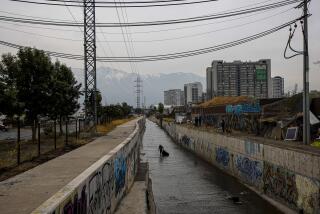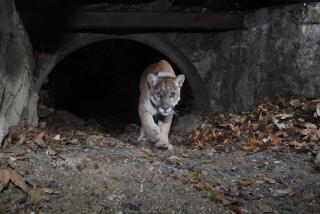CHILE’S : NEW FRONTIER : Meandering for 745 miles through Patagonia, the new Pinochet Highway has opened a : virtually unspoiled wilderness of lakes and glaciers, mountains and ranches in South America.
- Share via
COIHAIQUE, Chile — Although it is just a simple gravel road, the President Pinochet Longitudinal Southern Highway fully deserves its grandiloquent name.
Meandering south for 745 miles from Puerto Montt, Chile’s southernmost major city (about 600 miles south of Santiago), to the small village of Villa O’Higgins, the new highway has opened a region of overwhelming natural beauty.
Just as important, its opening means that southern Chile at last can join the rest of the country in the economic revolution that accompanied former president Augusto Pinochet’s 16 years of repressive military rule.
Until now, few tourists have had the opportunity to visit this part of the country, truly one of the world’s last frontiers. Here is a stunning and varied landscape: lakes turned emerald green by volcanic minerals, vast steel-blue glaciers clinging to the peaks of the Andes, ancient rain forests and the world’s deepest fiords.
Begun in 1976, all but the southernmost 120 miles of the highway have been completed. Another 800 miles of east-west branch roads are built or planned, meaning that even the most remote areas are becoming accessible.
Travel on the highway can mean a backpacking odyssey or a comfortable bus tour, a budget camping adventure or a leisurely journey by rented car with stops in comfortable, if not luxurious, hotels. Many young Chilean hitchhikers make the trip, as do a few groups of hardy mountain bicyclists. Solitary hikers travel the road on foot.
There are a few discouraging obstacles for travelers in an area that is at once enchanting and forbidding. The oft-leaden skies of this cold territory prompted Ferdinand Magellan, in 1520, to call these “the lands of December.”
But when the sun pokes through a rent in the clouds and sets a tiny fishing village alight in golden hues as you round a bend and emerge from the forest, the reward is fully worth gambling with the fickle weather.
Chile’s newly elected democratic government hopes that more foreigners will now want to get to know the nation’s many natural beauties. The drive south also offers a chance to get to know the people.
Southern Chileans are a quieter, gentler people than their feisty brethren in the smoggy, hustling capital, Santiago, and their hospitality is a matter of justifiable pride. Visitors still are rare, so tarrying to chat is the order of the day. Some stretches of the road see fewer than 50 cars a day at the height of the Southern Hemisphere summer in January and February.
The pioneer folk who came before the highway opened are especially self-reliant, having had to travel until recently by horse, still the main source of transportation in these parts, or by the occasional ferry. Many faces reveal the mixed ancestry of Spanish settlers and Mapuche Indians who once roamed here.
Other colonists, however, retain their heritage. Southern Chile was heavily settled by Germans, and their influence is evident in both the architecture of peaked-roof homes with yellow wooden shingles and in the German conversations commonly heard in shops.
The highway also has brought to the region skilled young professionals from the north who are opening salmon hatcheries in the fiords or building hotels for the growing tourist trade. Some towns have doubled in size, although most are still humble villages of a few hundred settler families. Most towns are new and functional rather than quaint, and all have a rough-edged frontier feeling.
But the size of the area, 54,000 square miles, with only about 100,000 inhabitants, ensures plenty of solitude for those who want it. You will drive 30 to 50 miles at a stretch without seeing a home (or a gas station--fill up whenever you can), but nowhere is the air more pure, the water more clear.
When leaving Puerto Montt, a grandiose overhead superhighway-style sign announces the start of the Pinochet Highway. The goal for many travelers often is Coihaique, a town of about 37,000 and capital of the district of Aisen, about 400 miles south along the highway from Puerto Montt.
The intrepid may want to venture farther south to Lake General Carrera, the second-largest lake in South America and site of spectacular rainbow trout fishing. The last accessible point is Cochrane near the vast Northern Ice Field.
One attraction of the highway is the range of possible circuits. I chose the land route all the way from Puerto Montt, which sweeps southeast from the city, around beautiful Reloncavi Bay and south to the coastal town of Chaiten.
A simple but attractive hillside hotel, Mi Casa, overlooks the town and the bay and offers a pleasant dining room. Try to book ahead here and elsewhere if possible. When the one or two decent hotels in these towns are full, the option can be a dank rooming house with a cold-water bathroom.
For those who want to skip the first section and start the highway drive from Chaiten, car ferries leave most mornings from Puerto Montt. The journey takes about eight hours. You can also drive southwest from the city and cross over to Chiloe, a 120-mile-long island of rolling farmland and wooden 18th-Century country churches. Midway down the island is the small port of Chonchi, a departure point for four-hour car-ferry crossings to Chaiten.
Cars can be rented in Puerto Montt for the trip (there are no objections to their use on gravel), and can be dropped off in Coihaique. Although not essential, four-wheel-drive is reassuring.
Travel companies are beginning to put together combination minibus and ferry tours with hotels arranged, which may prove more attractive to non-Spanish speakers.
Unless you are hitchhiking and camping, the journey is not necessarily cheap. Given the remoteness and lack of competition, decent hotels and meals can be pricey; for example, $70 for a double in the Hotel Coihaique, a quality single-story inn on the edge of town with a good restaurant, and most rooms facing the mountains.
Budget travel is safe (Chile is probably Latin America’s lowest security risk for tourists) but it can be slow. I gave a ride to three young Chileans at one ferry landing who had waited three days for someone to stop; they were nearly berserk with restlessness.
The highway weaves around awesome snow-topped mountains, lakes, rivers and ocean inlets. The builders simply could not surmount some of the physical barriers and still keep the project affordable. Thus along the 135-mile first leg from Puerto Montt to Chaiten there are three ferries, one a splendid 2 1/2-hour trip through a mountain-lined fiord. The ferry passes a narrow inlet where the German warship Dresden hid from the British fleet in 1915 during World War I.
You can do the whole Puerto Montt-Chaiten land-and-ferry leg in one long day, but it’s less of a strain to make the first short ferry crossing and stay the night in the village of Rio Negro (also called Hornopiren), which is prospering from the salmon business. The Hotel Holiday, a simple two-story wooden inn with views of the pretty ocean bay, is the best, at about $25 a room. The owners will turn on the hot water when you want to shower.
The next day you can make the second and longest ferry ride at 8 a.m. It’s an hour’s drive from Rio Negro, on a stretch of highway cut into the steep slope alongside the sea, one of the tougher engineering challenges for the highway builders. A third short ferry follows after a six-mile jog across a forested peninsula.
You need to concentrate while driving. Potholes abound, trucks speed around nearly blind corners and the gravel roadbed is slippery when wet. Plan on averaging 20-25 m.p.h. If you have an accident or breakdown, it may be an hour or two before someone turns up. In some stretches you travel for 30 miles or more without seeing a two-legged creature.
From Chaiten you can comfortably travel to Las Juntas, a growing cattle and logging area without much charm but with excellent trout fishing. Better yet, head on to the prettier town of Puyuhuapi, settled by German immigrants in the 1930s, at the head of a narrow fiord with mountains towering. The town has a gasoline station, a handmade carpet factory and two well-kept German farmhouse inns.
The Termas de Puyuhuapi is a fine renovated thermal baths inn with luxurious rooms and an excellent dining room overlooking a peaceful inlet, about eight miles south of town on the other side of the fiord.
It’s a treat to luxuriate in its full-size thermal swimming pool, even if the air temperature is 50 degrees or less, and then stretch out in a small, older pool, almost too hot to enter at first. The hotel is planning two-day and longer trips of the surrounding channels and, some of which have been sold by the government recently for as little as $20 an acre. The trips are made in the hotel’s yachts .
Heading south from Puyuhuapi, be sure to make the short detour to El Colgante, a glacier wedged into a mountain cliff in a national park. You can hike and camp near the lookout point.
It’s a healthy day’s drive from Puyuhuapi to Coihaique, about 125 miles farther south, and this section of the highway is among the most spectacular. The road winds along the edge of ocean channels, over a pass to the eastern slopes of the Andes and through untouched evergreen forests with glaciers and ice fields on the hillsides.
Nature lovers will be horrified by the damage in the valley around Coihaique caused by immense forest fires, intentionally set by a handful of settlers to clear land for grazing in the 1940s. The landscape is still terribly scarred, a reminder of the fragility of the rain forests.
The region east of the Andes is on the edge of the vast cattle- and sheep-grazing plains that stretch into Argentine Patagonia. Proud Chilean gauchos, cowboys on horseback wearing baggy black pants and berets, share the highway with cars and trucks.
The highway is paved for the last six glorious miles into Coihaique because it overlaps with the 45-mile lateral road from Coihaique to Puerto Chacabuco at the sea.
I never made it far south of Coihaique, but many say the Chile Chico area on Lake General Carrera is lovely, and that when the final leg of the road is finished over the next four or five years, virtually unknown areas will be opened to visitors.
Many travelers refuse to leave the area without making the two-day trip by sea from Puerto Chacabuco to San Rafael Lagoon to see its famed, immense glacier, an ice field that flows into the sea. A whiskey served with 30,000-year-old glacial ice is customary.
To return north, those with cars can go by ferry from Puerto Chacabuco, either directly to Puerto Montt or to Chonchi on Chiloe island, at least four a week in summer. You can get airline-style seats for the 22-hour trip for less than half the $100 cabin price. Reserve in summer for these ferries.
The ship, often carrying trucks of cattle to market, winds along Aisen fiord, through dozens of steep-cliffed islands and north through a broad channel and then the Gulf of Corcovado to Chiloe. It can be wrenching in bad weather, but unforgettable on a clear evening.
After arriving at the picturesque port of Chonchi, an easy four-hour drive takes you back to Puerto Montt.
More to Read
Sign up for The Wild
We’ll help you find the best places to hike, bike and run, as well as the perfect silent spots for meditation and yoga.
You may occasionally receive promotional content from the Los Angeles Times.






